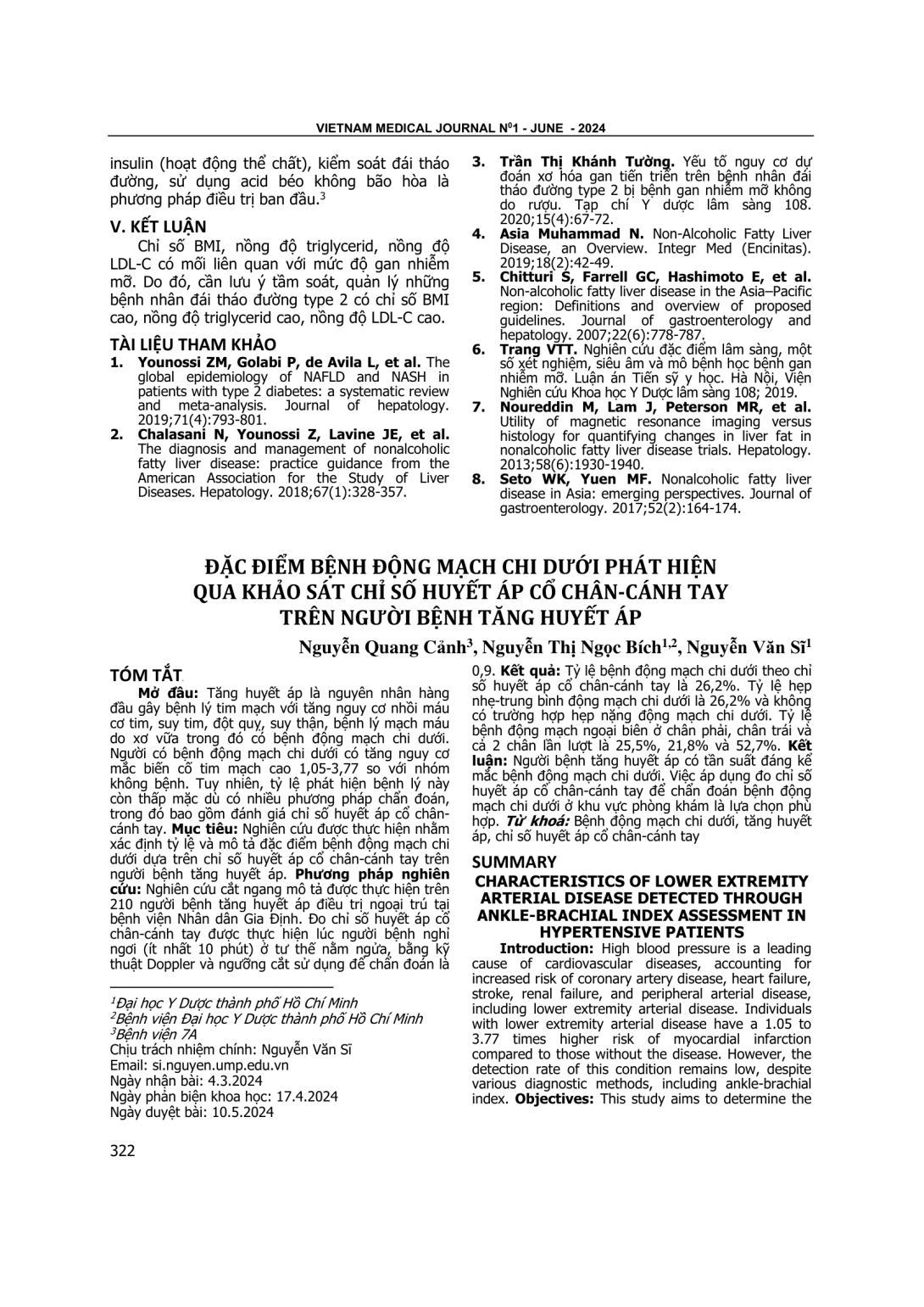
Tăng huyết áp là nguyên nhân hàng đầu gây bệnh lý tim mạch với tăng nguy cơ nhồi máu cơ tim, suy tim, đột quỵ, suy thận, bệnh lý mạch máu do xơ vữa trong đó có bệnh động mạch chi dưới. Người có bệnh động mạch chi dưới có tăng nguy cơ mắc biến cố tim mạch cao 1,05-3,77 so với nhóm không bệnh. Tuy nhiên, tỷ lệ phát hiện bệnh lý này còn thấp mặc dù có nhiều phương pháp chẩn đoán, trong đó bao gồm đánh giá chỉ số huyết áp cổ chân-cánh tay. Mục tiêu: Nghiên cứu được thực hiện nhằm xác định tỷ lệ và mô tả đặc điểm bệnh động mạch chi dưới dựa trên chỉ số huyết áp cổ chân-cánh tay trên người bệnh tăng huyết áp. Phương pháp nghiên cứu: Nghiên cứu cắt ngang mô tả được thực hiện trên 210 người bệnh tăng huyết áp điều trị ngoại trú tại bệnh viện Nhân dân Gia Định. Đo chỉ số huyết áp cổ chân-cánh tay được thực hiện lúc người bệnh nghỉ ngơi (ít nhất 10 phút) ở tư thế nằm ngửa, bằng kỹ thuật Doppler và ngưỡng cắt sử dụng để chẩn đoán là 0,9. Kết quả: Tỷ lệ bệnh động mạch chi dưới theo chỉ số huyết áp cổ chân-cánh tay là 26,2%. Tỷ lệ hẹp nhẹ-trung bình động mạch chi dưới là 26,2% và không có trường hợp hẹp nặng động mạch chi dưới. Tỷ lệ bệnh động mạch ngoại biên ở chân phải, chân trái và cả 2 chân lần lượt là 25,5%, 21,8% và 52,7%. Kết luận: Người bệnh tăng huyết áp có tần suất đáng kể mắc bệnh động mạch chi dưới. Việc áp dụng đo chỉ số huyết áp cổ chân-cánh tay để chẩn đoán bệnh động mạch chi dưới ở khu vực phòng khám là lựa chọn phù hợp.
High blood pressure is a leading cause of cardiovascular diseases, accounting for increased risk of coronary artery disease, heart failure, stroke, renal failure, and peripheral arterial disease, including lower extremity arterial disease. Individuals with lower extremity arterial disease have a 1.05 to 3.77 times higher risk of myocardial infarction compared to those without the disease. However, the detection rate of this condition remains low, despite various diagnostic methods, including ankle-brachial index. Objectives: This study aims to determine the prevalence and describe the characteristics of lower extremity arterial disease based on the ankle-brachial index in patients with hypertension. Methods: A cross-sectional descriptive study was conducted on 210 outpatient hypertensive patients at Nhan Dan Gia Dinh Hospital. Ankle-brachial index measurements were taken while patients were at rest (at least 10 minutes) in a supine position using Doppler ultrasound and the diagnostic cutoff value of 0.9 was chosen. Results: The prevalence of lower extremity arterial disease based on the ankle-brachial index was 26.2%. The rates of mild to moderate lower extremity arterial stenosis were 26.2%, with no cases of severe stenosis. The prevalence of lower extremity arterial disease in the right leg, left leg and both legs was 25.5%, 21.8%, and 52.7%, respectively. Conclusions: Patients with hypertension have a significant frequency of lower extremity arterial disease. The application of ankle-brachial index measurements for diagnosing lower extremity arterial disease in outpatient settings is a suitable option.
- Đăng nhập để gửi ý kiến
